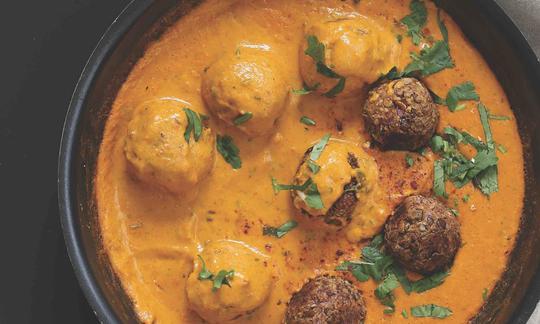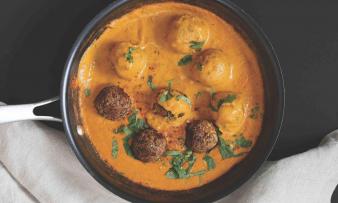Table of contents
The vegan Makhani sauce with garam masala and fresh tomatoes, based on a recipe by Richa Hingle, is used as a basic sauce in many Indian dishes. It is sometimes also found as Makhani Masala. This sauce is easy to make in organic quality, but is not raw.
Use in the kitchen
Makhani sauce or butter sauce is an important ingredient in many Indian dishes such as butter chicken (murgh makhani), dal or paneer dishes. Traditionally, the sauce is based on butter or ghee (clarified butter, pure butter fat) and fresh tomatoes. The Makhani sauce taste can be described as rich, spicy, creamy, with a slight sweetness. The typical aroma is due to the intense spices it contains. Makhani sauce is usually not vegan and does not have a vegan main course. But it can be easily adapted and is in no way inferior to the original.
Makhani Dal dishes are usually prepared with brown lentils and possibly kidney beans. Seitan can also be used instead of chicken in the Chicken Makhani recipe. Fragrant rice (basmati or jasmine rice), papadams/papad (fried flatbreads made from lentil flour) or vegan naan bread are delicious as side dishes. This basic sauce goes perfectly with lentil dumplings or in a pilaf (oriental rice dish). You can find both recipes in this book: "Richa's culinary world of flavors ".
Homemade
vegan Makhani sauce is quick and easy to make yourself. You can find the exact vegan Makhani sauce recipe with Garam Masala here. Make sure the ingredients are organic.
The main steps are: Sauté the cumin and coriander seeds and, if using, the bay leaf in a pan with hot oil for one minute. Then add the chopped garlic, onions and ginger. Add the turmeric, cayenne pepper and garam masala and sauté the ingredients, stirring occasionally. Add the fresh, diced tomatoes, cashews, salt and water (alternatively almond milk) and simmer, stirring occasionally, until the tomatoes have a sauce-like consistency. Allow to cool slightly, remove the bay leaf and pour the sauce into a blender. Add more water (or almond milk) and puree the sauce until smooth. Finally, pour the vegan makhani sauce into a container or pan, where you can use it straight away. Mix in the fenugreek leaves and sugar and season to taste.
You can vary the recipe a lot (also adaptable to raw food quality). Spices can be cardamom, cumin, cloves, cinnamon, coriander,pepper, garam masala and fenugreek (Punjabi / Hindi: Kasuri Methi). Cashew paste is sometimes used as a thickener and the final seasoning is fresh coriander leaves.
According to Richa Hingle, for a nut-free alternative, silken tofu or coconut cream ( coconut cream is better because it doesn't contain sugar) can be used instead of cashews. However, since coconut products contain a lot of saturated fatty acids, we recommend not using them at all or only using them very sparingly!
Vegan Cauliflower Recipe with Makhani Sauce (Makhani Gobi)
Ingredients (serves 4): 2 cups vegan makhani sauce, 2 cauliflowers (medium size), for the marinade; ½ cup plant-based yogurt (e.g. soya), 1 tbsp salt, ½ tbsp turmeric powder, ½ tbsp fenugreek leaves, 1 tbsp garlic paste, 1 tbsp ginger paste, 1 tbsp garam masala, 2 tbsp rapeseed oil (refined).
Preparation: Separate the cauliflower florets from the stem and leaves, break into small to medium pieces, wash well and pat dry. Mix all the ingredients for the marinade (except the oil) in a bowl. Put the florets in the bowl, marinate and leave to stand for about 30 minutes. Keep the marinade and set aside. Add 2 tablespoons of rapeseed oil to a pan and fry the marinated florets, stirring occasionally, until they are half cooked and all the liquid has evaporated. In a saucepan, bring the vegan makhani sauce to the boil, reduce heat and add the cauliflower. Simmer partially covered until the cauliflower is soft but not falling apart. Cover until ready to serve and serve the vegan makhani gobi with vegan naan bread or fragrant rice (basmati or jasmine rice).
Vegan recipes with Makhani sauce can be found under the note: " Recipes that have the most of this ingredient ".
| Not only vegans or vegetarians should read this: Vegans often eat unhealthily. Avoidable nutritional errors. |
Purchasing - Storage
Where can you buy vegan butter chicken sauce? Butter chicken sauce is not traditionally made vegan. You can buy the ingredients for a freshly prepared vegan Makhani sauce in Asian shops or in special Indian grocery stores, but also in well-stocked supermarket branches such as Coop, Migros, Denner, Volg, Spar, Aldi, Lidl, Rewe, Edeka, Hofer, Billa or in organic supermarkets such as Denn's Biomarkt and Alnatura. Online you can often find Makhani spice mixes in powder form, made from whole spices or as a paste. Makhani paste is often sold under the name "Butter Chicken". When using ready meals or spice mixes, pay attention to the milk products, preservatives or acidifiers they contain.
The availability of Makhani spice mixtures or pastes varies depending on the size of the store, catchment area, etc. Our recorded food prices for the DA-CH countries can be found above under the ingredient image - and by clicking on them you can see their development at various suppliers.
Storage tips:
Homemade vegan Makhani sauce will keep for up to three days in an airtight container in the refrigerator, or up to two months when frozen. Purchased sauces should be used quickly after opening.
Ingredients - Nutritional values - Calories
The nutritional values refer to the recipe for homemade vegan Makhani sauce with Garam Masala. The proportions of nutrients may vary depending on the choice of ingredients.
The sauce contains 73 kcal per 100 g. This includes 4.1 g/100 fat, 8.4 g/100g carbohydrates and 2 g/100g protein. 1
The vegan Makhani sauce contains 0.36 mg/100g of manganese (18% of the daily requirement). Almost four times this amount is found in the Laksa curry paste with turmeric and ginger (1.3 mg/100g). This trace element, which is important for the formation of cartilage tissue, is present in higher quantities in nuts and seeds, such as hazelnuts (6.2 g/100g) or pumpkin seeds (4.5 g/100g). 1
Potassium is present at 222 mg/100g (10% of the daily requirement). Similar amounts are found in salsa verde (221 mg/100g) or umeboshi paste (208 mg/100g). Red Thai curry paste contains almost twice as much of this essential element (397 mg/100g). Potassium is present in most foods. Good sources include dried herbs, such as dried parsley (2680 mg/100g) or dried basil (2630 mg/100g), although much smaller amounts are used in cooking. 1
100 g of vegan Makhani sauce contains 8.9 mg of vitamin C (11% of the daily requirement). Vitamin C is particularly abundant in fruits, berries and vegetables. Umeboshi paste contains comparable amounts of 6 mg/100g. Red Thai curry paste (38 mg/100g) and salsa verde (55 mg/100g) contain significantly more of this important antioxidant. 1
The complete ingredients of vegan Makhani sauce, the coverage of the daily requirement and comparison values with other ingredients can be found in our nutrient tables. In the article Nutrients explained you will get a detailed insight into the topic.
Health effects
The Makhani sauce recipe contains a whole range of ingredients. Fresh tomatoes and the spice mixture Garam Masala are among the main ingredients in the recipe. The nutrients contained in tomatoes are known for their antioxidant properties 2, help reduce the risk of cancer and can reduce the risk of obesity, hyperglycemia, hypercholesterolemia and cardiovascular disease. 3,4 The Garam Masala recipe used also contains numerous individual ingredients. The healthy effect of the spice mixture therefore varies slightly depending on its composition. Nevertheless, research has shown that many of the spices typically contained in it have antioxidant properties. Cinnamon, for example, has antimicrobial, anti-inflammatory, antidiabetic and lipid-lowering properties. 5
For more information about the ingredients of Makhani sauce and their health benefits, click on the recipe below.
Dangers - Intolerances - Side effects
Makhani sauce, prepared traditionally, contains large amounts of butter, cream and (coconut) milk. These ingredients are rich in saturated fatty acids and increase the risk of coronary heart disease when consumed in large quantities. The Federal Nutrition Commission ( EEK) recommends an intake of saturated fatty acids of <10% of the energy consumed per day. Fats with a high proportion of saturated fatty acids should also be replaced with fats with a high proportion of unsaturated fatty acids. 6 The vegan alternative, as described in our recipe, excludes animal fats and therefore contains significantly fewer saturated fatty acids. At most, possible intolerances or side effects due to the cashew nuts it contains may occur in people with a nut allergy.
Ecological footprint - animal welfare
The CO2 footprint of a food depends on various factors. The type of agricultural production (conventional vs. organic), seasonal, regional, domestic production or import by truck, ship or plane, different types of packaging and whether the goods are fresh or frozen all play a decisive role.
The vegan Makhani sauce can be classified as a climate-friendly ingredient when made at home. Greenpeace, in cooperation with Eaternity and others, has compiled many CO2 footprints of foods and put them in relation to their nutritional value. All of the ingredients needed for the Makhani sauce, except for star anise in the Garam Masala spice mix, have a very good ecological balance. In relation to their nutritional value, their CO2 footprint meets the goal of a climate-friendly diet (50% better than average). 8 We have not found any concrete values for an industrially manufactured product. But for comparison: raw tomatoes have a CO2 footprint of 0.46 kg CO2 eq/kg; for a processed product such as tomato ketchup, the value rises to 1.9 kg CO2 eq/kg. 11 When purchasing ingredients, look for fair trade and organic certifications and make as much as possible yourself.
The water footprint of the spices contained in Makhani sauce is very high. For example, coriander seeds have a water footprint of 8280 l/kg and cinnamon even 15,526 l/kg. Ginger (1657 l/kg) and garlic (589 l/kg) have a smaller footprint. 9 However, all of these ingredients are used very sparingly; therefore, you can put the water consumption into perspective and still classify Makhani sauce as resource-saving.
For detailed explanations of various sustainability indicators (such as ecological footprint, CO2 footprint, water footprint), see our article: What does the ecological footprint mean?
Animal welfare - species protection
Pesticides do not only affect pests. Agricultural landscapes are home to many beneficial organisms - for example, pesticides are also fatal or extremely damaging to spiders, bees, grasshoppers or beetles. In the EU, almost a quarter of endangered species are threatened by pesticides. The decreasing biodiversity is disrupting ecosystems. Whether earthworms, birds or us humans, the chemicals are harmful to everyone. Since farmers in organic farming do not use synthetic pesticides and chemical fertilizers, organic Makhani sauce is preferable for the sake of health as well as flora and fauna. 10
Worldwide occurrence - cultivation
Makhani sauce is very popular in India and is used as a tasty ingredient in many traditional dishes. As Indian cuisine spread around the world, the popularity of this sauce also increased and today, thanks to its simplicity and adaptability, it is increasingly finding its way onto the ingredient lists of amateur cooks.
Information on the cultivation and occurrence of the ingredients contained in the vegan Makhani sauce can be found directly in the recipe.
Industrial production
Makhani sauce is produced industrially, mainly in the form of pastes. Since these are not traditionally prepared vegan, dairy products are often included in ready-made products.
Further information
The word "Makhani" comes from the Indian language; "makkhan" means butter. The sauce originally comes from northern India (Punjab). 7
Alternative names
In English, Makhani sauce is known as "butter chicken" or "murgh makhani". It is also called Makhani Masala, Makhanwala Sauce or Garam Masala Sauce.
Incorrect spellings such as Makhansauce, Mackhansauce, Makhan Sauce, Makani Sauce, Makhani Saice, Makahni, Makheni, Makhni Sauce, Makahani, mahkani Sauce, Makhini, Makni Sauce, Makkhani, Makhani Sause, Mahkni Sauce, Makhanr or Makhami can occur.
Bibliography - 11 Sources (Link to the evidence)
| 1. | USDA United States Department of Agriculture. |
| 2. | Salehi B, Sharifi-Rad R et al. Beneficial effects and potential risks of tomato consumption for human health: An overview. Nutrition. 2019;62:201-208. |
| 3. | Perveen R, Suleria HAR et al. Tomato (Solanum lycopersicum) carotenoids and lycopenes chemistry; metabolism, absorption, nutrition, and allied health claims--a comprehensive review. Crit Rev Food Sci Nutr. 2015;55(7):919-929. |
| 4. | Cheng HM, Koutsidis G et al. Tomato and lycopene supplementation and cardiovascular risk factors: A systematic review and meta-analysis. Atherosclerosis. 2017;257:100-108. |
| 5. | Rao PV, Gan SH. Cinnamon: a multifaceted medicinal plant. Evid Based Complement Alternat Med. 2014;2014:642942. |
| 6. | Eidgenössische Ernährungskommission. EEK Bericht: Fette in der Ernährung. 2012 (pdf). |
| 7. | eCurry com: Makhani Masala / Butter based Tomato Cream Sauce. 2010. |
| 8. | Greenpeace Schweiz, Stadt Zürich, Planted Foods AG, Branding Cuisine, Tinkerbelle, Inge, myblueplanet, ProVeg International, Dr. Earth, FightBack und Eaternity. All You Can Eatfor climate - Poster. ayce.earth. 2022. |
| 9. | Mekonnen MM, Hoekstra AY. A Global Assessment of the Water Footprint of Farm Animal Products. Ecosystems. 2012;15(3):401–415. |
| 10. | Zaller J. Unser tägliches Gift: Pestizide die unterschätzte Gefahr. 1. Auflage. Wien: Deuticke im Paul Zsolnay; 2018: 116-130; 146. |
| 11. | Concito. The big climate database. Version 1.1 2024. |









Comments